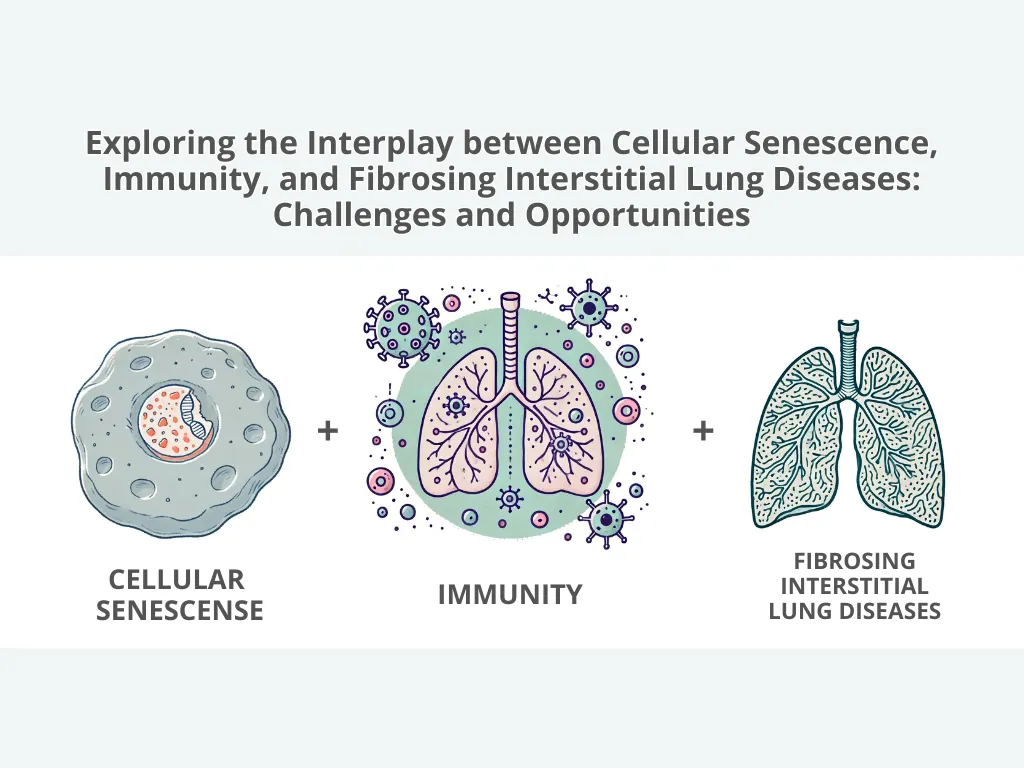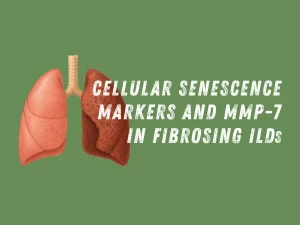Exploring the Interplay between Cellular Senescence, Immunity, and Fibrosing Interstitial Lung Diseases (f-ILDs): Challenges and Opportunities

Understanding the Role of Cellular Senescence in f-ILDs (Fibrosing Interstitial Lung Diseases)
Fibrosing interstitial lung diseases (ILDs) are characterized by the gradual and irreversible accumulation of scar tissue in the lung parenchyma.
The role of the immune response in the pathogenesis of pulmonary fibrosis remains unclear. In recent years, substantial advancements have been made in our comprehension of the pathobiology driving fibrosing ILDs, particularly concerning various age-related cellular disturbances and immune mechanisms believed to contribute to an inadequate response to stress and increased susceptibility to lung fibrosis.
Methods:
Emerging studies emphasize cellular senescence as a key mechanism implicated in the pathobiology of age-related diseases, including pulmonary fibrosis.
Results:
Cellular senescence, marked by antagonistic pleiotropy, and the complex interplay with immunity, are pivotal in comprehending many aspects of lung fibrosis.
How Cellular Senescence Contributes to Immune Dysregulation and f-ILDs: Key Findings
Here, we review progress in novel concepts in cellular senescence, its association with the dysregulation of the immune response, and the evidence underlining its detrimental role in fibrosing ILDs.
Authors
Fernanda Hernandez-Gonzalez, Federico Pietrocola, Paolo Cameli, Elena Bargagli, Sergio Prieto-González, Tamara Cruz, Nuria Mendoza, Mauricio Rojas, Manuel Serrano, Alvar Agustí, Rosa Faner, Jose A. Gómez-Puerta and Jacobo Sellares
Read more details at
Fecha de publicación
Available online 2 September 2024
Categorías asociadas al artículo
Noticias relacionadas

Cellular Senescence Markers and Matrix Metalloproteinase-7 Are Co-expressed in Fibrosing Interstitial Lung Diseases
Study highlights the role of cellular senescence markers (p16, p21) and MMP-7 co-expression in fibrosing interstitial lung diseases.

Impact of Ex Vivo Lung Perfusion System on the Lung Microbiome
Discover how ex vivo lung perfusion (EVLP) impacts the lung microbiome and its implications for improving donor lung viability and reducing transplant complications.

Falling through the cracks: what happens to survivors of preterm birth?
Survivors of preterm birth face increased risks of respiratory diseases, yet awareness among specialists is low. This study examines gaps in long-term care, highlighting the need for clear follow-up guidelines and improved communication between medical teams.
Artículos
Fibrosis
- 768786·Mate Maus et al. Iron accumulation drives fibrosis, senescence and the senescence-associated secretory phenotype
- 769072·Tamara Cruz et Al. – Lung immune signatures define two groups of end-stage IPF patients
- 769275·Nuria Mendoza et al. Blood Immunophenotypes of Idiopathic Pulmonary Fibrosis: Relationship with Disease Severity and Progression
- 779185·Vincent Cottin et Al. Syndrome of Combined Pulmonary Fibrosis and Emphysema. An Official ATS/ERS/JRS/ALAT Research Statement.
- 779376·Gerard J. Criner, Alvar Agusti, Hossein Borghaei, Joseph Friedberg, Fernando J. Martinez, Curtis Miyamoto, Claus F. Vogelmeier, Bartolome R. Celli.Chronic Obstructive Pulmonary Disease and Lung Cancer: A Review for Clinicians
Imagen desarrollada DALL·E, Canva y retoque gráfico.
